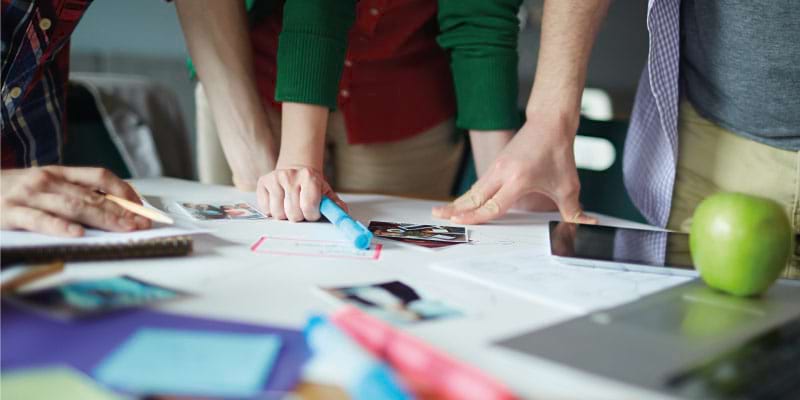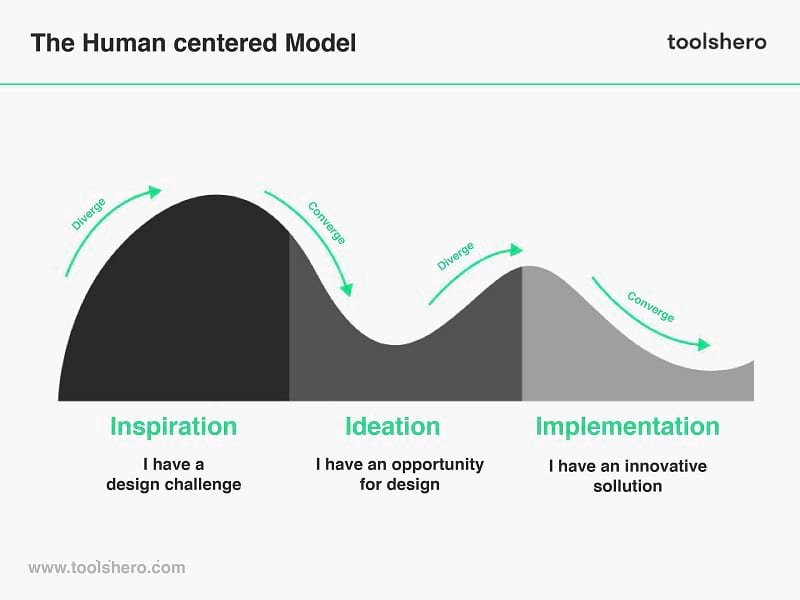Human Centered Design Process

Human Centered Design: this article explains Human Centered Design in a practical way, developed by Brown & Wyatt. This article contains a general definition of this theory, its process, phases and practical tips. After reading it, you will understand the basics of this quality management tool. Enjoy reading!
What is Human Centered Design?
Human Centered Design is an ISO standard and approach applied in design and management situations of products services where solutions to problems are developed by considering the human perspective as the most important.
People involvement is typically observed within the context of a problem through brainstorming, conceptualizing and developing plus implementing a solution. It’s also an approach to problem solving.
The definition of Human Centered Design
In the ISO manuals, it is defined as follows: Human Centered Design is an approach to interactive systems development with the aim of making the systems usable by focusing on the users, their demands, wants and needs, and by applying human factors and usability knowledge.
This approach increases as key element the effectiveness of the solution, improves human well-being, user experience, accessibility and sustainability and stimulates creative problem solving.
In addition, it counteracts human adverse effects, for example on health, safety and performance.
Human Centered Design: the three phases
This approach consists of three phases. The first phase, the inspiration phase, consists of immersing the designer in the user’s world. What is their life like? What needs do they have? What would they benefit greatly from?
The second phase, the ideation phase, is all about understanding what has been learned in the first phase. This means that opportunities and requirements for design specifications are determined and first prototypes are developed.
The third phase, the implementation phase, consists of implementing the solution and launching the final solution on the market.
The above phases are further explained in the article.

Figure 1 – the proces for Human Centered Design
Customer-oriented design?
In the heat of battle, read: every day in a start-up, it’s important to keep in mind whom all the work is done for: the customers. At the end of the day, system function designs are meant for them.
A people-oriented design approach helps to shift the focus back onto the customers.
Why is that important? Start-ups often struggle with prototypes and costly adjustments to them. One way to improve the prototyping process is to put humans in the center from the very beginning.
People-oriented design asks designers to ask questions that help them understand the design and requirements.
- How do my customers rate the performance of the design?
- How do they assess the quality of the design? And the sustainability?
- Which features are must haves? Which are nice to have? Which are not important?
- How is the product used by the customer and what does maintenance look like? What about repairs when a defect occurs?
These questions show that it is not possible to simulate the answer of the customers in mind. Direct contact with the customer is indispensable.
IDEO
IDEO is a company that has made the values of Human Centered Design its own. IDEO is a design and consultancy firm with offices all over the world.
The company uses design thinking, other design methods and Human Centered Design principles to design products, environments, services and experiences.
It started with a focus on designing consumer products such as toothbrushes and computers. After the turn of the century, IDEO started to pay more attention to developing user experiences.
Human Centered Design process
The process of people-oriented design in system development consists of three phases as described. These are further explained below.
Phase 1: Inspiration
The aim of this phase is to understand the customers and their needs on a human level. Clearly formulate the problem that needs to be solved in advance, without being too detailed or too superficial. This is an important step because it defines the bandwidth of the process.
The next step in this phase is to draw up a project plan and put together a team. Think about the timeline, key milestones, staff, budget and capabilities. Depending on the complexity and nature of the project, a multidisciplinary team is quickly created in which technical knowledge and market knowledge are combined.
After this, it is time to create a clear context through secondary research. The design is shaped with input from the latest news, recent innovations and existing solutions.
Once that’s done, it’s time for interviews. IDEO recommends that no more than three research members attend the interviews. Everyone who is present must also be given a clear role. Prepare well, come up with good questions and start broad. Write exactly what each employee says and the implications of this.
Phase 2: Ideation
This phase of the human centered approach involves understanding the input from the first phase, creating ideas, identifying possible solutions and testing. In this phase, have the different team members sit in a circle and share their insights. This can be done by means of post-its on a large wall or poster board. Add inspiring stories and demands from the interviews to this.
When this “blueprint” is ready, it’s time to synthesize ideas. Start by identifying the top 5 themes that stand out because they are more frequent or very specific. This helps to generate ideas and gain valuable insights. Are there themes that come up more often?
Then we start with statements of insight. These are short and clear sentences in which the most important insights gained are shared. An important insight is, for example, that people indicate that they find it painful to look at a computer monitor for a longer period of time. Then translate the insight statement into an opportunity for the design team: how can we develop a computer monitor that better protects users’ eyes?
When all design options have been written out, it is time to brainstorm. Generate as many ideas as possible. Group similar ideas into themes. These will ultimately determine the design principles. Design principles influence the actual product design.
Feedback on the concept helps determine which prototypes will be built. Also use storyboards, role plays, rapid prototyping and other forms of prototyping here to gain new insights. Seek as much feedback as possible and repeat this step several times.
Phase 3: Implementation
In this phase the final product is put on the market. Some companies start with live prototyping, while others use their solution in the real world for several weeks. In this way they test and can optimize a certain part of the solution.
Companies that have the resources to do so can also choose to carry out a long-term pilot. With this they gather critical feedback and other important statistics.
The financing strategy is therefore of great importance. It ensures that the right people have access to the money needed to organize a successful launch and get the business off the ground. Keep in mind that this strategy is different for each launch. Check when break-even will be made and how the initial strategy will be converted for the medium to long term.
In any case, define what success looks like in different time frames. Do you work with partners? Then make sure you know what success looks like with them.
Human Centered Design principles
The principles of Human Centered Design are well described by Don Norman in a field guide. Below is a brief explanation.
Focus on people
The first principle states that people should be at the center of the process. Whatever needs to be designed, the people who will be using the product are the most important in this process.
These people are not abstract figures, but physical people with whom conversations can be started. In many cases, the product is a tool for the people to help them achieve their goals. Theodore Levitt summed this up powerfully in his popular quote: “People don’t want to buy a quarter-inch drill bit, they want a quarter-inch hole.”
Find the right problem to solve
Not all problems are worth solving. Normal distinguishes two kinds of problems: fundamental problems and symptoms of another problem. This means that it is essential to first identify and solve a fundamental problem before looking at other problems.
The only way to identify such fundamental problems is by looking at user experiences, user feedback and needs. Problems are noticed and recognized by asking the right questions, such as the 5-times why method.
Start thinking of everything as a system
Product designers still too often regard a product as a collection of individual functions that together deliver value to the user.
From a technical perspective, such an approach can be beneficial, but it is wrong to think this way when it comes to a user experience. People see and use a product as an entire experience, not as a collection of short moments and individual features.
This requires a holistic mindset. All parts in a product are interconnected and optimizing just 1 part can have a huge impact on the overall user experience.
Repeat solutions
It is very difficult to develop a perfect solution on a first attempt. That is why it is important to invest in rapid prototyping: fast building and validation.
Only when using prototypes designers can see how users use the solution. The feedback they gather during this process is incorporated into the final product design.
By going through this cycle again and again, a state is eventually reached where the product is almost perfect.
Now it’s your turn
What do you think? Do you recognize the explanation about Human Centered Design? Do you ever work on designs for systems or working methods? What topic would you like to see an article on? Do you have any tips or comments?
Share your experience and knowledge in the comments box below.
More information
- Cooley, M. (2000). Human-centered design. Information design, 59-81.
- Zoltowski, C. B., Oakes, W. C., & Cardella, M. E. (2012). Students’ ways of experiencing human‐centered design. Journal of Engineering Education, 101(1), 28-59.
- Norman, D. A. (2005). Human-centered design considered harmful. interactions, 12(4), 14-19.
- Buchanan, R. (2001). Human dignity and human rights: Thoughts on the principles of human-centered design. Design issues, 17(3), 35-39.
How to cite this article:
Janse, B. (2021). Human Centered Design Process. Retrieved [insert date] from Toolshero: https://www.toolshero.com/quality-management/human-centered-design/
Original publication date: 03/14/2021 | Last update: 07/06/2023
Add a link to this page on your website:
<a href=”https://www.toolshero.com/quality-management/human-centered-design/”>Toolshero: Human Centered Design Process</a>











